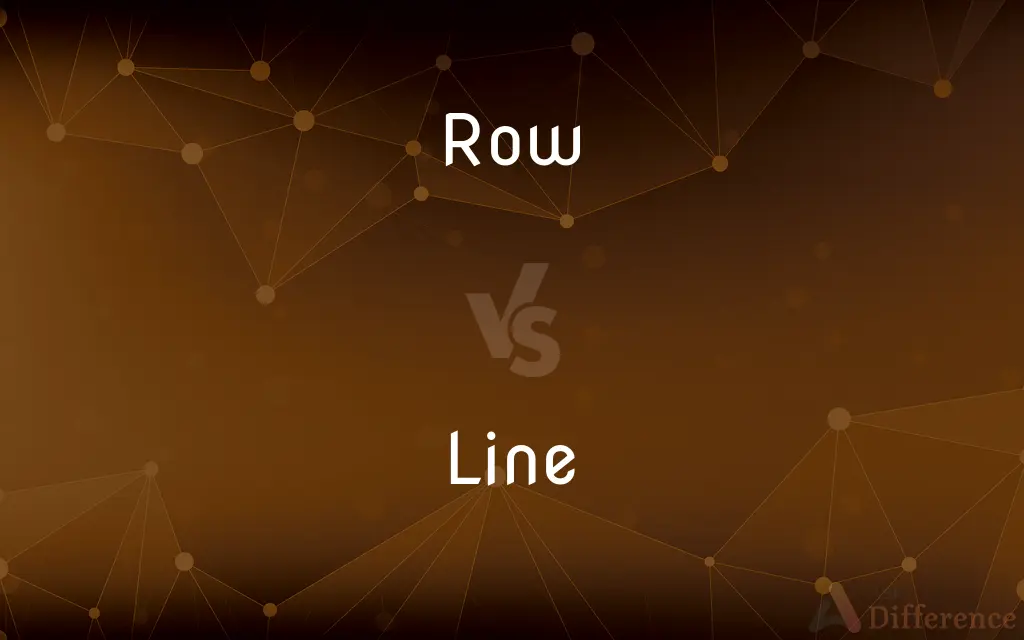Row vs. Line — What's the Difference?
By Urooj Arif & Fiza Rafique — Updated on March 5, 2024
A row refers to a horizontal arrangement of items, often in a table or matrix, while a line can be a string of text or people arranged without a specific direction.

Difference Between Row and Line
Table of Contents
ADVERTISEMENT
Key Differences
Rows are typically seen in the context of tables, spreadsheets, or seating, where they run horizontally from left to right. This organization is essential for structuring data or people in an accessible manner. On the other hand, a line refers to a continuous mark, as drawn by a pen, or a formation of people or objects, which can be straight or curved. Lines are fundamental in geometry, art, and organization, guiding viewers' eyes or managing queues.
While rows are integral to data representation, allowing for an orderly arrangement and easy comparison of information side by side, lines play a crucial role in both physical and conceptual forms. Lines can delineate boundaries, create forms in art, or indicate direction in maps. Unlike rows, which are inherently part of a larger grid or matrix, lines can exist independently, serving as connectors or dividers.
Rows serve as a record holder, with each row representing a unique dataset aligned horizontally in spreadsheets. This makes it easier to read and interpret data by looking across from left to right. Conversely, a line of text in a document or a queue of people does not necessarily convey a relational dataset but follows a sequential or narrative order, leading the eye or movement in a specific direction.
The concept of a row is also prevalent in physical layouts, such as in theaters or classrooms, where it facilitates structured seating and clear pathways. In contrast, lines are more versatile, appearing in various contexts from the physical lines people form when waiting to the abstract lines that make up drawings or diagrams.
Rows and lines both contribute to organization and structure in different contexts. Rows emphasize horizontal arrangement and are fundamental in settings where data comparison or systematic order is key. Meanwhile, lines, with their ability to be straight or curved, play versatile roles in dividing spaces, directing movement, and expressing ideas in visual arts.
ADVERTISEMENT
Comparison Chart
Definition
A horizontal arrangement of items.
A continuous mark or formation without specific direction.
Context
Tables, seating, spreadsheets.
Text, queues, drawings, boundaries.
Directionality
Horizontal
Any direction (straight, curved, vertical, etc.)
Function
Organizes data or items side by side.
Divides, connects, directs, or outlines.
Independence
Often part of a matrix or grid.
Can exist independently.
Compare with Definitions
Row
A horizontal line of cells in a table or spreadsheet.
Each row in the spreadsheet contains data for a different client.
Line
A row of people or things in a sequential order.
There was a long line at the coffee shop this morning.
Row
A series of people or things lined up horizontally.
The children stood in a row during the school assembly.
Line
A direction or path along which something moves or lies.
The storm moved in a straight line across the county.
Row
A horizontal arrangement of plants or trees.
The farmer planted the crops in long rows for easier irrigation.
Line
A method of organization or a boundary.
The line between work and personal life is often blurred.
Row
A series of items placed next to each other, typically in a horizontal line.
The books were arranged in a neat row on the shelf.
Line
A long, narrow mark or band.
She drew a straight line across the paper.
Row
A line of seats in a theater, cinema, or classroom.
We got seats in the front row for the concert.
Line
Text forming a single row.
Please enter your address in the line provided.
Row
A series of objects placed next to each other, usually in a straight line.
Line
(Mathematics) A geometric object with neither width nor depth, typically straight and extending indefinitely.
Row
A succession without a break or gap in time
Won the title for three years in a row.
Line
A thin continuous mark, as that made by a pen, pencil, or brush applied to a surface.
Row
A line of adjacent seats, as in a theater, auditorium, or classroom.
Line
One's trade, occupation, or field of interest
What line of work are you in?.
Row
A continual loud noise.
Who's making that row?
Line
Merchandise or services of a similar or related nature
Carries a complete line of small tools.
Row
An arrangement of objects or people side by side in a line;
A row of chairs
Line
A sequence of related things that leads to a certain ending
A line of argument.
Row
A linear array of numbers side by side
Line
Make a mark or lines on a surface;
Draw a line
Trace the outline of a figure in the sand
Line
Fill plentifully;
Line one's pockets
Line
Reinforce with fabric;
Lined books are more enduring
Common Curiosities
Can a line be horizontal?
Yes, a line can be horizontal, vertical, straight, or curved, depending on its context and purpose.
What is a row?
A row is a horizontal arrangement of items, often found in tables, spreadsheets, or seating arrangements.
How do rows and lines differ in spreadsheets?
Rows in spreadsheets run horizontally and are used to organize data side by side, whereas a line might refer to a line of text within a cell or a border line between cells.
Are rows always straight?
Yes, in the context of data organization and seating, rows are typically straight to facilitate structure and comparison.
What is a line?
A line can refer to a continuous mark, a sequence of text, or a formation of people or objects arranged without specific direction.
What role do lines play in art?
In art, lines can define shapes, direct the viewer's eye, create texture, or convey emotion, depending on their direction, width, and style.
How do rows enhance data interpretation?
Rows allow data to be organized horizontally, making it easier to compare information across different datasets side by side.
Can lines form shapes?
Yes, lines can form shapes when they connect at points or intersect, contributing to the creation of two-dimensional or three-dimensional forms.
What distinguishes a row of text from a line of text?
The terms are often used interchangeably in the context of text; however, a "line" can refer to any direction in drawing or physical space, whereas a "row" emphasizes horizontal arrangement.
Can rows and lines intersect?
In the context of grids or tables, rows (horizontal) and columns (vertical) intersect, but "lines" in a broader sense can intersect or overlap in various ways depending on the context.
Why are rows important in seating arrangements?
Rows organize seats in a way that maximizes space, ensures everyone has a clear view, and facilitates movement within the venue.
Is a queue considered a line or a row?
A queue is considered a line, as it refers to a sequence of people or things arranged in order, typically without specifying direction.
How do lines affect visual composition?
Lines can guide the viewer's attention, create movement, establish boundaries, and contribute to the balance and harmony of a visual composition.
How are rows used in databases?
In databases, each row represents a unique record, containing related data fields aligned horizontally for ease of reading and organization.
Can a line be considered a row?
Conceptually, a line can be considered a row if it refers to a horizontal arrangement of text or items, but traditionally, "line" has a broader and more varied meaning.
Share Your Discovery

Previous Comparison
Buttermilk vs. Kefir
Next Comparison
Fidget vs. SquirmAuthor Spotlight
Written by
Urooj ArifUrooj is a skilled content writer at Ask Difference, known for her exceptional ability to simplify complex topics into engaging and informative content. With a passion for research and a flair for clear, concise writing, she consistently delivers articles that resonate with our diverse audience.
Co-written by
Fiza RafiqueFiza Rafique is a skilled content writer at AskDifference.com, where she meticulously refines and enhances written pieces. Drawing from her vast editorial expertise, Fiza ensures clarity, accuracy, and precision in every article. Passionate about language, she continually seeks to elevate the quality of content for readers worldwide.














































